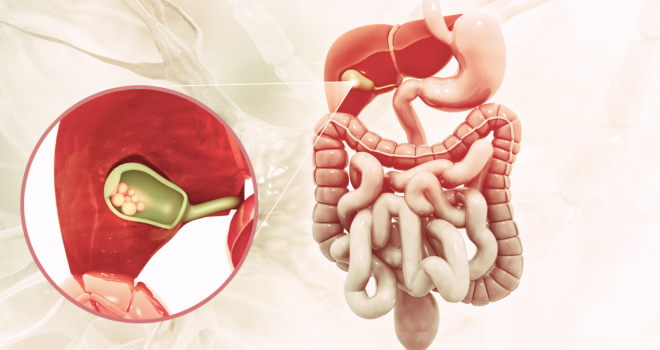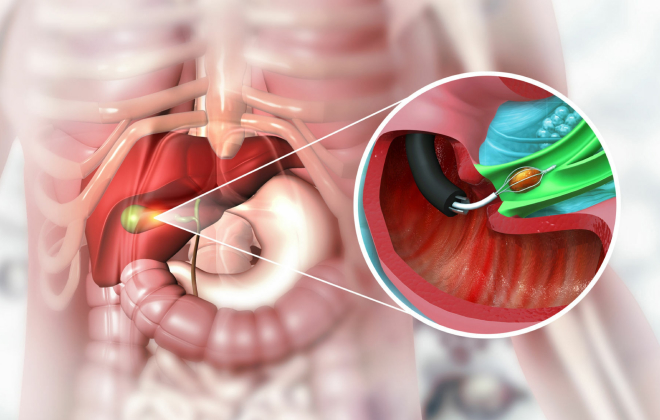


Have you ever been suddenly hit by intense pain in your upper abdomen?
It could be a sign of gallstones. Gallstones are small, hard deposits that form in your gallbladder, almost like pebbles. This small organ, tucked beneath your liver, has a crucial role – it stores and releases bile, a yellow-green fluid essential for breaking down fats in your diet.
Gallstones are a common disease, in fact in Malaysia, gallstones affect about 10% of adults. Certain demographics such as women, older individuals, those who are obese, and people with specific medical conditions or dietary habits are more prone to developing them.
In this blog, we will dive into this common disease, exploring its causes, symptoms, and the latest treatment methods.
Several factors, including cholesterol levels or bilirubin in your bile, can disrupt the balance and cause these substances to harden into solid deposits.
One of the leading causes is too much cholesterol or bilirubin in your bile, which can happen if your liver produces more than your gallbladder can handle or if your diet is high in fat or cholesterol.
Another cause is inadequate emptying of your gallbladder, which can happen if your gallbladder is inflamed, damaged, or scarred or if you fast or skip meals.
Genetic factors such as a family history of gallstones, as well as certain medical conditions such as diabetes, cirrhosis, or hemolytic anaemia, contribute to gallstone formation.
Additionally, your lifestyle and diet choices, such as being overweight, having rapid weight loss, or consuming a diet low in fibre and high in carbohydrates, also play a role in this issue.
Gallstones can cause serious problems by blocking the bile ducts which transport your bile to your small intestine. This may result in side effects such as inflammation or infection of your gallbladder, liver, or pancreas, which can cause severe pain, fever, chills, nausea, vomiting, jaundice, and yellowing of your skin and eyes.
If left untreated, these complications can damage your organs and even be life-threatening. In rare cases, gallstones can also increase your risk of developing gallbladder cancer, which is a type of cancer that starts in the cells of your gallbladder.

There are primarily two types of gallstones: cholesterol stones and pigment stones. Cholesterol stones are the most common, forming from excess cholesterol in your bile.
On the other hand, pigment stones develop from an excess of bilirubin, a byproduct of your red blood cells.
Gallstones can cause a variety of signs and symptoms based on their quantity, location, and size. The most common and noticeable symptom is acute, excruciating pain in the upper right or centre of your abdomen, especially after eating a fatty meal.
The pain may last a few minutes to several hours and spread to your right shoulder or between your shoulder blades. You may also feel nauseous or vomit during a gallstone attack. Gallstones induce inflammation by obstructing the bile ducts or spasms in your gallbladder or bile ducts, leading to these symptoms.
However, not all gallstones cause symptoms. Some gallstones are silent and do not cause any problems. Imaging tests or surgery for other reasons may discover them. Treatment is not necessary for silent gallstones unless they cause complications.
If you have symptoms of gallstones that are persistent or severe, or if you notice signs of infection or jaundice, such as fever, chills, yellowing of your skin or eyes, or dark urine, you should seek medical attention as soon as possible. These signs may indicate a serious complication, such as an infection or inflammation of your gallbladder, liver, or pancreas, which can be life-threatening if left untreated.
Here are some of the standard procedures and tests used to identify gallstones and their complications:
It is the most common and non-invasive test to look for signs of gallstones. This test uses sound waves to create images of your abdomen and show your gallbladder and bile ducts’ size, shape, and location. It can also detect gallstones, inflammation, or blockage in your gallbladder or bile ducts. This test is painless and takes about 15 to 20 minutes to complete. You may need to fast for a few hours before the test to get a clear image of your gallbladder.
Endoscopic ultrasound can identify smaller stones that an abdominal ultrasound may miss. A flexible tube equipped with an ultrasound tool, an ultrasonic probe, and a camera at the end called an endoscope is inserted into your digestive tract to examine your gallbladder and bile ducts from the inside. It can also take samples of tissue or fluid for further testing. This test is more invasive and requires sedation and local anaesthesia. Before the test, you should refrain from taking specific medications and fast for a few hours. You may also experience some soreness or bloating after the test.
Imaging tests, such as oral cholecystography, HIDA scan, CT scan, MRCP, or ERCP, can also be used for diagnosis. These tests can provide more detailed information on your gallbladder, bile ducts, and pancreas. They use different methods, such as contrast dye, radioactive tracer, X-rays, or magnetic fields, to create images of your gallbladder and bile ducts and show how well they function. They can also detect gallstones, inflammation, infection, or blockage in your gallbladder or bile ducts. These tests may require fasting, drinking a special liquid, or taking an injection before the test. They may also have risks or side effects, such as allergic reactions, radiation exposure, or bleeding, hence has to be conducted only under the guidance and supervision of a medical professional.
Blood tests can reveal infection, jaundice, pancreatitis, or other complications caused by gallstones. These tests quantify the concentrations of specific substances in your blood, such as liver enzymes, bilirubin, amylase, lipase, or white blood cells, that can indicate how well your liver, gallbladder, and pancreas are working. They can also detect any signs of infection or inflammation in your body. These tests are simple and quick and only require a small blood sample from your arm. Your doctor will review each test’s advantages and concerns and help you choose the best one for your condition.
The severity of your gallstone symptoms and how you manage them will determine how likely you are to develop complications. You may not need treatment if you have silent gallstones that do not cause problems.
However, if you have symptomatic gallstones that cause pain, infection, or jaundice, you may need one of the following treatment options:
The most common procedure is a cholecystectomy, which removes the gallbladder and is an effective treatment for symptomatic gallstones. It is a safe and permanent way to remove gallstones and prevent them from returning. Based on your condition and preference, you can undergo the surgery either as a laparoscopic or an open procedure.
This surgery usually takes about an hour, and you may need to stay in the hospital for one or two days. You can resume your normal activities within a few weeks, but you may need to avoid fatty foods and eat smaller meals for a while. Most people can live normally without a gallbladder, but some may experience diarrhoea, bloating, or gas after the surgery.
If surgery is not possible or preferred, such as in cases of other medical problems or pregnancy, you may use medications to dissolve the gallstones. These medications are taken orally or injected into the gallbladder and work by dissolving the cholesterol stones over time.
However, this treatment may take months or years to work and may not be effective for all gallstones. The medications may also have side effects like nausea, headache, or skin rash. The gallstones may also recur after stopping the medicines.
Shockwave therapy, which breaks up gallstones, can be used alongside medications. However, this approach may come with side effects and limitations. This treatment uses high-energy sound waves to shatter the gallstones into smaller pieces that can pass through the bile ducts.
However, this treatment may not work for large or multiple gallstones and may cause pain, bleeding, or infection. The gallstones may also recur after the treatment.
Whether you have undergone surgery, medications, or shockwave therapy to treat your gallstones, you may need to make some lifestyle and dietary adjustments to prevent or manage any complications or recurrence of gallstones. Here are some tips for your long-term management and monitoring:
After your gallstone treatment, you may need to follow some instructions from your doctor, such as taking painkillers, antibiotics, or anti-inflammatory drugs or putting off heavy lifting or other demanding tasks for a while. You may also need to change your diet, especially if you have had your gallbladder removed. Fried, spicy, and greasy foods may be off limits for you and eat smaller and more frequent meals.
You may also need to increase your fibre intake, fruits, vegetables, and lean proteins, and reduce your sugar, salt, and refined carbohydrate intake. These dietary changes can help you improve your digestion, lower your cholesterol levels, and prevent gallstone formation.
Even after your gallstone treatment, you may still need to monitor your condition and check for any signs of gallbladder issues or recurrence of gallstones. You may need regular check-ups and ultrasound scans to see how your gallbladder, liver, and pancreas are functioning and to detect any gallstones that may have formed or remained.
Blood tests may also be necessary to examine your liver enzymes, bilirubin, and cholesterol levels and rule out infections or inflammation. These tests can help you prevent or treat any complications or recurrence of gallstones.
If you have mild symptoms such as occasional pain, nausea, or bloating, you can manage them at home with simple remedies. You may use heat pads or hot water bottles to warm your abdomen, reducing discomfort and calming the muscles.
You may also drink plenty of water and herbal teas with ingredients like ginger, chamomile, or peppermint, which can help soothe your stomach and improve your bile flow.

In our exploration of gallstones in this blog post, we’ve delved into these hard, pebble-like deposits found in the gallbladder – a small but vital organ in charge of holding and excreting bile aid fat digestion. Gallstones are a common issue, affecting numerous individuals, and the serious complications they can cause, like blockages in the bile ducts leading to infection, inflammation, and, in rare cases, cancer in the gallbladder, liver, or pancreas.
A range of treatments are available for treating gallstones. Consult an experienced doctor if you are facing any of the symptoms. Timely intervention can help you avoid bigger complications in the future.
The first signs of having gallstones may be an unexpected and excruciating pain in the top right or centre of the abdomen, especially after eating a fatty meal. The pain can last anywhere from a few minutes to several hours and often comes with nausea or vomiting.
An imbalance of the substances in the bile such as cholesterol or bilirubin results in the formation of gallstones. This can be caused due to various factors, such as genetics, diet, lifestyle, obesity, rapid weight loss, pregnancy, etc.
Some gallstones may go away without surgery, especially if they are small and do not cause symptoms. However, this may take a long time and may not be guaranteed.
Sources:
Spread the love, follow us on our social media channels